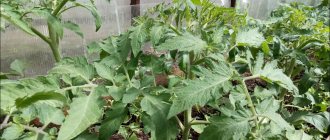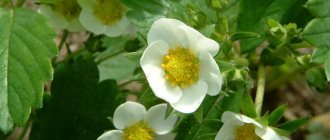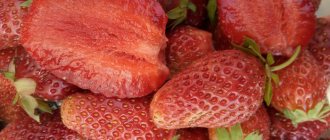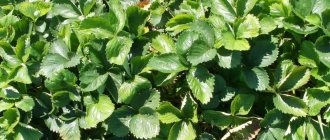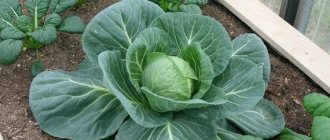What to do if strawberries bloom, but there are no berries on them? Why is this happening? These questions are asked by many summer residents who grow the queen of berries - strawberries (garden strawberries). Let's try to find the reasons and ways to solve this problem.
The lack of berries on strawberries (this is what most summer residents are accustomed to calling garden strawberries) after the bushes have bloomed profusely can be caused by both objective reasons independent of the summer resident, and by errors in caring for strawberries.
Reason 1. Lack of pollinator variety
Most strawberry varieties are bisexual, i.e. Both male and female flowers are produced on the same plant. These plants only need their own pollen for pollination. However, there are varieties, for example Komsomolka, Mitze Schindler, Miracle of Keten, on the bushes of which there are only unisexual pistillate flowers and therefore self-pollination cannot occur. For this, strawberries need bushes of other varieties - pollinator plants.
If you grow strawberries of just such varieties, then the problem of the lack of berries on them after flowering can be solved very simply - plant several bushes of a pollinating variety in the garden next to the main variety.
What to do if the reason is not clear?
If you can’t identify the reason for the lack of fruits on strawberry bushes, you need to take care of comfortable growing conditions for them. Regularly loosen the soil after each watering to prevent oxygen starvation of the roots, remove weeds from the site, which only take away moisture and nutritional components from the soil.
Apply fertilizer compounds to the soil in a timely manner and carry out treatments against harmful insects and diseases. This approach will allow the plants to recover and begin to bear fruit.
Reason 2: Lack of pollinating insects
One of the main reasons why strawberries bloom well, but there are no berries afterwards, is the lack of bees and other pollinating insects. This often happens in rainy summers: bees, bumblebees and other pollinators do not fly in the rain.
They will not appear in your beds even if you overuse fertilizers: bees fly around places with a “chemical” smell.
You can attract pollinating insects to your site with a sweet aroma. To do this, prepare syrup from sugar or honey. For the first, dissolve 1 tbsp in 1 liter of water. Sahara. To make sweet water from honey, add 2 tbsp to 5 liters of water. honey Spray the strawberry bushes with any of the resulting solutions. The sweet smell will attract insects to your garden bed.
You can also use honey plants. When they bloom, they will lure bees and other pollinators into your area with their scent. Plant cornflower, calendula, geranium, sage, mint, matthiola and other aromatic plants as honey plants.
- 6 Secrets of a Flower Garden That Attracts Bees
What can you do to make bees love your garden?
Reason 3. Cold weather
Sometimes the reason for the lack of ovaries on strawberry bushes strewn with flowers can be weather surprises, for example, an unexpected cold snap that occurs during budding and flowering. This usually happens with early strawberry varieties that bloom in early to mid-May. How to help strawberries in this situation?
Cover the strawberry bushes with plastic film or any non-woven material: agrofibre, spunbond, lutrasil, etc.
Another way to protect plants from impending frost is to create a smoke screen. In the evening, place dry straw, grass or brushwood near the strawberry bed. Cover the whole thing with a layer of damp material on top: grass clippings, weeds, turf, etc. At night, before frost sets in, set the pile on fire. The smoke that appears will be able to protect your plantings during slight frost.
- Situation: what to do if frosts are predicted, but the trees and bushes are already in full bloom
We often lose our harvest of fruits and berries due to frosts while the garden is blooming in the spring. Is it possible to somehow influence the situation?
Reason 4. Inappropriate place
Strawberries are a light-loving plant: they should be illuminated by the sun for at least 6-8 hours a day. For this reason, when distributing beds, give this berry the sunniest place. Also choose your strawberry neighbors carefully. Do not plant it next to tall plants, trees or shrubs that will shade the bed.
You should also pay attention to your predecessors. Garden strawberries should not be planted after strawberries and other representatives of the Rosaceae family. All nightshade crops are not suitable as predecessors for strawberries. The Colorado potato beetle and wireworm left behind from potatoes will harm it. Tomatoes leave behind soil with a high level of acidity - and strawberries don’t like this either.
You should not plant strawberries after cruciferous crops, as well as cucumbers, zucchini and sunflowers. Violation of the rules of crop rotation can lead to the absence of ovaries on strawberries even after abundant flowering.
Only if all of the above conditions are met can one hope for a good strawberry harvest.
- 12 key points when growing garden strawberries
Garden strawberries, better known as strawberries, are one of the most popular berries in our gardens. And yet, many questions arise regarding its cultivation.
Improper watering of strawberries
Strawberries can be finicky when it comes to their water needs. The bushes have a relatively shallow root system. This causes them to absorb most of their water from the top few centimeters of soil. It is also the soil that dries out the fastest as temperatures rise.
Because strawberry plants require significant and consistent amounts of water to produce their best results, continually drying out the top layers of soil can cause the plants to go into survival mode. They don't produce many or good quality strawberries in dry soil. Additionally, watering too much will stunt plant growth and strawberry production. In fact, plants will die if they remain in standing water for too long. It is important to plant strawberry plants in well-drained soil to prevent standing water from drowning any part of the plant.
Reason 5. Soil
Sometimes it seems that everything is going fine: the strawberries have bloomed well, and a large number of green ovaries have appeared on the bushes. However, that’s where it all ends: the ovaries stop developing, dry out, and the harvest never comes. In this case, most likely the reason is watering or soil.
During the period of ovary ripening, strawberries need a lot of moisture. If the weather is hot, there is no rain and the soil in the garden bed is dry, water the strawberries daily during this entire period.
Strawberries may also lack berries due to a lack of essential nutrients in the soil. During fruit set, bushes especially need potassium and phosphorus. You can replenish their reserves in different ways:
- Pour 1 cup of ash into 10 liters of water, mix and leave to steep for 2-3 days. Pour the prepared ash infusion over the row spacing: 10 liters per 1-1.5 linear meters.
- To enhance the effect, ash can be combined with whey: 1 glass of ash per 1 liter of whey.
- You can also help strawberries with yeast feeding. Dissolve 100 g of raw yeast in one bucket of warm water. After a day, the fertilizing is ready: pour about 0.5 liters under each bush.
- Potassium monophosphate is another way to replenish soil potassium and phosphorus reserves. Dissolve the preparation in water (1 tablespoon per bucket of water) and pour it over the strawberry bushes.
Nitrogen fertilizing at this stage of development of garden strawberries leads to increased growth of green mass to the detriment of fruit set.
- How to feed strawberries during fruiting
If the strawberries become smaller and lose their pleasant taste, it means that you urgently need to take care of feeding the bushes with useful substances.
Varieties
Strawberries don't bloom but produce mustaches
There are hundreds of varieties of strawberries. Only 73 varieties are registered in Russia.
To ensure high yields and tasty berries, you need to choose elite varieties:
- Temptation. Hybrid. Early ripening, large-fruited variety. High yield - about 3 kg of berries are harvested from one bush. Flesh with a slight musky flavor.
- Queen Elizabeth 2. The pride of Russian breeders. In one season they get 2 harvests. The taste of the pulp is sweet, honey. This remontant variety has excellent transportability and frost resistance.
- Mara de bois. Hybrid. The berries are round in shape and very sweet. The variety has high frost resistance.
- Honey. A very popular early ripening American variety. Resistant to bad weather, gray rot, and tick attacks. Used in industrial preparations.
- Mashenka. An early ripening variety, distinguished by very large berries. One berry weighs 100 g. It has good survival rate and resistance to diseases.
- Kimberly. Dutch hybrid variety. The fruit is heart-shaped, has a caramel flavor with a slight sourness. One berry can weigh from 15 to 20 g. One of the advantages of the variety is the low degree of adaptation.
- Gigantella. Very large fruits, the weight of one berry can reach up to 125 g. The pulp is characterized by juiciness and a sweet, slightly pineapple taste. Withstands transportation well.
Regardless of the variety chosen, high strawberry yields can only be achieved with proper care.
Reason 6. Pests of garden strawberries
Strawberries bloom, but the ovaries do not appear even if the plant is affected by insect pests.
Sometimes on the bushes you can find red-brown spots or stripes on the peduncle and a dried stalk - these are traces of the presence of strawberry stem nematode. These microscopic worms are located inside the stem and clog the vessels that carry water and nutrients. As a result of the vital activity of nematodes, flowers and ovaries dry out and fall off, and bushes stop growing. There are no commercially available means of effectively controlling these pests, so affected plants must be dug up and destroyed. If a large number of bushes are affected, then you need to remove them all. You can plant strawberries in this place no earlier than after 4 years - that is how long nematodes live in the soil.
Another pest of strawberries is no less dangerous - the strawberry weevil. During the flowering of garden strawberries, the female weevil gnaws a hole in the bud and lays an egg there. Soon a larva emerges from the egg and feeds on the internal contents of the bud. As a result, the strawberries bloom, but some time after flowering the ovaries dry out and fall off.
To protect yourself from weevils, 5-6 days before strawberries bloom, treat them with any insecticides that fight this pest, for example Inta-Vir or Iskra.
- Strawberry pests: how to recognize and fight
Garden strawberries (strawberries) are an attractive “target” for many pests, the most dangerous of which we will talk about today.
Why there are no berries on strawberries: 5 reasons for the lack of fruiting
Degeneration, loss of varietal qualities
The solution in the absence or small number of berries, in the presence of fruits that are more deformed, with an excess number of seeds, is simply to change the planting material. Without regret, dig up the bed; if it is more than 5 years old, move it to a new place.
You can take a couple of rosettes with you, but remember: along with them you will also take a bouquet of diseases, fungal spots and viral ones, as well as voracious sweet-toothed pests - old beds have probably become their breeding ground.
If remontant strawberries have stopped bearing fruit, it is often recommended to rejuvenate them by dividing the bush. The advice is useful, but only for a year. By dividing the old mother root into several parts, next year we will get a small harvest, but just a small one - it will be the last. The root system can be divided, but physiologically it has used up all the reserves laid down genetically.
Also, you should not take distant rosettes for seedlings - only the first two, the very first from the mother plant: they are the most viable and promising.
Therefore, reluctantly, take this step - you will not regret it.
There are no berries on the strawberries - when did you plant them?
Another reason for the lack of berries (flowers, ovaries) is planting at the wrong time. Read the author’s publication about choosing the timing of planting strawberries.
Fruit buds of early varieties are laid in late summer - early autumn. If you planted strawberries just before the frost, the generative buds did not have time to form, and there is no time for differentiation (formation of fruit buds). All this shifts the timing of fruiting in the summer and significantly reduces fruit formation.
I'm sick!
Another reason is a fungal infection: if the plants are covered with red, dark spots, then the bushes probably suffer from one of the types of fungal spots - brown, white, angular.
By destroying the leaf apparatus, thanks to which plants absorb oxygen and the process of photosynthesis occurs, the disease also affects the fruiting of the crop. Strawberries may also fail to bear fruit due to fusarium wilt, a disease of the root system. At its initial stage, the plants have a stunted, dried out appearance, there are no berries, then they simply wither - the bushes can literally be pulled out of the soil, if you pull slightly - the root system dies.
This could also be the work of pests - cockchafer larvae, beetles that damage the root system, as well as weevils and slugs.
Is it all about feeding?
With a lack of nutrients - nitrogen, potassium, manganese, boron, iron, strawberry fruiting is extremely poor. When planting, organic matter + mineral complex is added, then - during flowering and ovary, the NPK mineral complex is applied at least twice - ready-made fertilizers in chelated form, complex, tank mixture through the fertigation system or 1/ cup of ash + 30 g of urea - as they say, whoever that's a lot. More details https://vizazh-2.ru/zemlyanika/ob-udobreniyah-dlya-klubniki-podrobno-ili-pitanie-vo-blago in this article.
Pollination, climate and pollinators
Lack of pollination is one of the reasons for the lack of berries - everything is fine in the garden, but there are no berries on the strawberries - they won’t bear fruit this year. Perhaps the ovary is missing due to problems with pollination. The culprit may be the outbreak of heat, the lack of pollinating insects - remember, they were not howled with insecticides and acaricides that act not selectively on the pest, but on all insects, including bees?
Some varieties need pollinators - extremely rarely, but these are found among strawberries - let us remind you that most of us grow garden strawberries. The productivity of others increases in the presence of a pollinator of another variety nearby - for example, in Vikoda, and vice versa, it is less in its absence.
Strawberries don't bloom!
Strawberries of productive age (up to 4 years) do not bloom - there are several reasons. The first reason for the lack of flowers and ovaries on strawberries is the lack of nutrients and moisture at the time of flower bud formation.
Generative buds were laid in August - early September of the previous year - so let’s remember why the plants did not receive enough of the plants needed to start the future harvest. That is why, after fruiting, the plants are fertilized and watered until September.
At extremely high temperatures during the ovary period - and the extreme begins after +30 C - the pollen loses its qualities and may even become sterile. No pollination - no berries. That is why they try to grow early varieties - so that drought does not occur during the ovary period.
One of the obvious reasons for the lack of flowers on strawberries is that they don’t bloom and that’s it! – death of flower buds during freezing, icing. By the way, covering material, film or agrofibre should not touch the plants in winter - frostbite is guaranteed.
Obvious Causes of Common Problems
If strawberry buds dry out and fall off before our eyes, this is due to pests. Strawberry weevil that lays eggs in buds and overwinters in plant debris. To combat it, insecticides are used, treating no later than 5 days before flowering; to prevent it, remove plant debris and loosen the soil in the root zone.
If the center (stigma) of the flowers has darkened, frost is to blame. In this case, the petals remain intact and do not change color or shape. The situation is critical: if the stigmas are dead, there will be no ovary. To prevent this from happening, do not plant plants in cold lowlands; cover them with agrofibre in early spring if there is a threat of return frost. To save the color from freezing, mist installations are used - moist air cools more slowly, and the rows are watered using sprinkling.
If you follow all the recommendations, provide all the conditions, but have not seen a stable harvest, the problem is in the variety. Out-of-grade, degenerate strawberries - alas, urgently look for a replacement, new planting material.
By listening to our advice, you won’t worry about why your strawberries don’t bear fruit – you’ll know what to do for a bountiful harvest.
Reason 7. Strawberry diseases
Unfortunately, strawberries and diseases are not spared. Some of them can lead to a lack of berries even after abundant flowering. One of these is white spotting. The disease affects peduncles and petioles - and the berries do not set.
Another spotting – brown (brown) – leads to the same result. Initially, dark spots appear on the leaves. Over time, they increase in size and the entire leaf darkens, turns brown and dries out. The peduncles turn black, the emerging berries dry out - the strawberries die.
These diseases can be caused by high air humidity, long-term cultivation of bushes in one place, late harvested garden beds (the fungus that leads to these diseases overwinters on dry leaves), etc. The best protection against them lies in prevention: follow agricultural practices, remove weeds in a timely manner and loosen the rows, lay dry mulch (straw or wood shavings) under the bushes during fruit set so that the flower stalks do not come into contact with the soil.
- Strawberry diseases: photo, description, treatment
From this material, presented in pictures, you will learn what strawberry diseases can deprive you of a harvest of delicious berries.
In order for strawberries to please you with a rich harvest after abundant flowering, you need to create favorable conditions for them and carefully monitor the condition of the plants, this will allow you to detect pests or signs of diseases in time.


